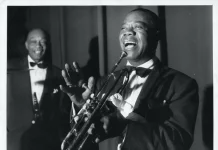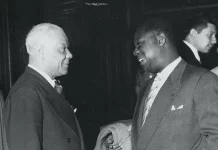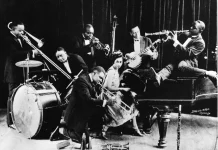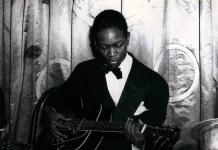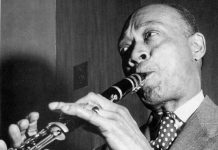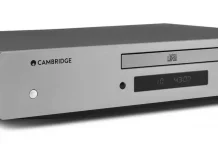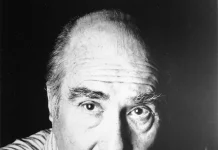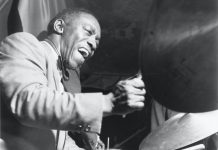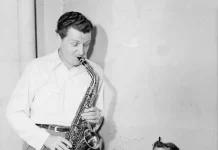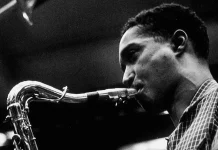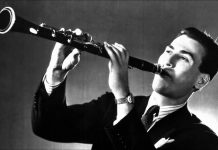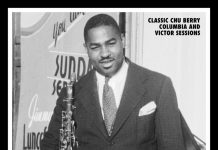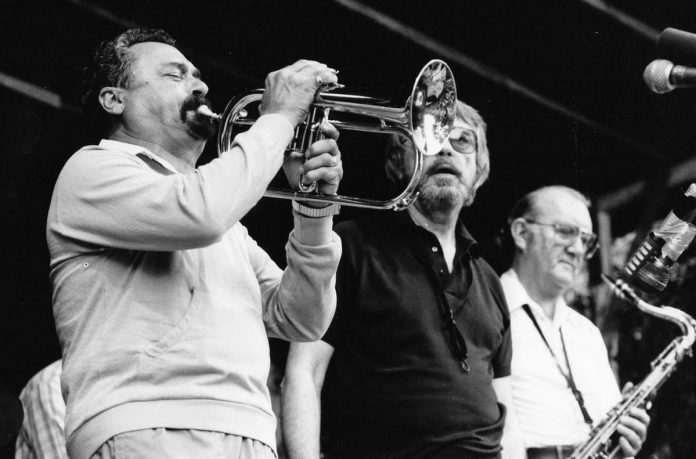
Shorty Rogers was one of the most multi-talented of the West Coast musicians of the 50s. He was a gifted improviser, who nonetheless was not ashamed to admit his devotion to the playing of Miles Davis, from whom he drew most of his inspiration. “The big influence on us at that time was the Miles Davis Capitol band … I got to know him and hung out with him while he was out here. I’m sure he must have heard my nine-piece, which owed so much to his inspiration, but he never mentioned it.”
And Shorty’s other great talent was writing arrangements. He wrote extensively for Herman and Kenton when he was in their bands and in 1970 he stopped playing to devote himself to his work for films and television series.
I sought him out at his Californian home in Van Nuys in 1980. Shorty was a quiet, shy man who always underestimated the size and loyalty of his audience. When I met him he was completely unaware of any European following. He took me to his den, a large wooden building in his garden that was far too elegant to be described as a shed. In it he had a multitude of treasures that he had collected during his life. I was able, for example, to hold Stravinsky’s original score of Ebony Concerto which he wrote for Woody’s band … and a trumpet mute that belonged to his friend Sonny Berman, who had died at the age of 21 in 1947, a few days after he and Shorty had left the Herman band.
Jenny and I spent the day at Shorty’s home and, as a guest, I was perhaps rude in my forceful haranguing to try to get him to come to Europe to play. But it was worth it, for I was instrumental in persuading him to eventually resume his jazz playing career in 1982.
His exhilarating music drew on Basie’s and Woody’s swing and incorporated the dynamics of Stan Kenton without any of the rigid bombast. Above all, Shorty’s music was downhome swinging.
Jordi Pujol of Fresh Sound Records was a Rogers fan, and he managed to include a dozen or so CDs by Shorty in his catalogue. Most of them are now deleted.
The diadem of what remains is an elegantly presented two-CD set, Shorty Rogers West Coast Sounds (FSR 2231), which includes the albums Cool And Crazy and Shorty Courts The Count. There are also more than a dozen tracks by the aforementioned early nine-piece. These earlier tracks have a brilliant cast of soloists including Shorty, Art Pepper, Jimmy Giuffre and Hampton Hawes. They do show Shorty experimenting with Miles’s Capitol sound before moving on to what became his killer album, Cool And Crazy. This combined skilled arranging with raw power, and quickly stood out as the most impressive big band set of the period. Five trumpets including Maynard upped the voltage and the album did a lot to finally bring Milt Bernhart and Bob Cooper to prominence as West Coast soloists away from their Kenton roots. But Shorty Courts The Count is one of the big swingers of the day, surpassing much of contemporary Woody Herman or Quincy Jones of the period, and remaining as fresh and exhilarating as it ever was to this day.
Speaking of Cool And Crazy, Shorty recalled that “By then I’d left Stan and I’d been playing at the Lighthouse for three years. A few of us who wanted to get off the road moved in there, and I went to Stan and asked if I could borrow some of his musicians – like 95% of the band, to make the album. He was delighted for me and anxious to do anything to help.
“The guys had been playing together so long that it didn’t take much rehearsal. We had only one. It was a wonderful band and of course we had the most wonderful lead trumpet of all time, Conrad Gozzo. I was able to use Maynard Ferguson on a lot of my sessions. There were times when I thought it would be cruel to write his parts so high, and then he’d come to me and say ‘Is it alright if I play this an octave higher?’ At that time he was just a young kid. In fact, when I first met him in Stan’s band he was so young that his mother and father were travelling with him. But he gave us a marvellous option.
‘I was able to use Maynard Ferguson on a lot of my sessions. There were times when I thought it would be cruel to write his parts so high, and then he’d come to me and say “Is it alright if I play this an octave higher?”‘
“Oddly enough we didn’t come up with the album title Cool And Crazy. The people at Victor had done some kind of research and they wanted an album named that.”
Another, equally elegant of Jordi’s albums, a three-CD set on FSR 2233, has the 30 or so tracks that Shorty recorded in his small group that included himself and Jimmy Giuffre as the front line, with Pete Jolly or Lou Levy on piano (the first-class pianists in Shorty’s groups also included men like Hampton Hawes, Marty Paich and Claude Williamson and the lineup was another guarantee of high quality). The box includes the famous “Martian” titles – Martians Go Home, Martians Come Back, March Of The Martians, Martians’ Lullaby and Martians Stay Home.
“The original one was Martians Go Home. Would you believe we found it amongst the graffiti in the men’s room at one of the clubs we were playing? It was an inside joke with the staff at the club, and I announced a little blues called that, and from then on we kept getting requests for it. The other titles were some of the offspring.
“I’ve always loved Latin things, and Jack Costanzo was one of the main influences here. When I was with Woody we did a tour with Nat Cole and Nat had Jack on bongos. We used to do a lot of writing on the bus, and I wrote down the rhythms he showed me.
“Basie was a powerful influence on me, too. When I was a kid in New York City I remember going to the Apollo Theatre – 15 cents, second balcony, every Friday. I’d play hooky to go. Ellington, Basie, you name it, it was there. But for me there was something very special about the energy that came out of the Basie band and its great soloists – Sweets Edison, Lester Young, all those guys and that great rhythm section. Later on I was very proud to have Sweets on one of our sessions and we became close friends.”

